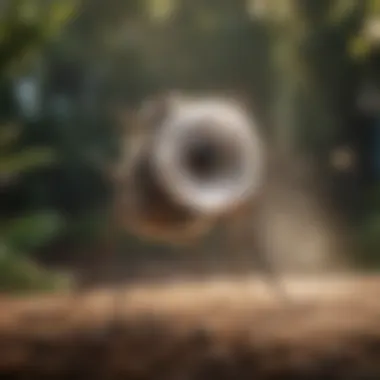Understanding Mosquito Misting Chemicals: Safety and Efficacy


Intro
Mosquitoes are more than just a nuisance. They can carry diseases that affect health and well-being. Understanding the mosquitoes themselves is crucial for effective control. This article will explore the chemicals used for misting, examining their efficacy, safety, and best practices. We will also look at their impact on the environment and alternatives that might be more suitable for certain situations.
Understanding the Pest
Identification
There are over 3,500 species of mosquitoes worldwide. They vary in size, color, and behavior. Identifying specific species can help homeowners understand their habits and the best methods for control. Common types include the Aedes aegypti, known for spreading dengue fever, and the Culex pipiens, which is often involved in West Nile virus transmission. Noting the physical features of mosquitoes, such as their size and marking patterns, aids in proper identification.
Life Cycle
Mosquitoes have a complex life cycle consisting of four distinct stages: egg, larva, pupa, and adult. Understanding this cycle is vital for effective control strategies.
- Egg: Mosquitoes lay eggs in still water, often in clusters.
- Larva: After a few days, eggs hatch into larvae. They live in water and feed on algae.
- Pupa: The larva changes into a pupa, which transitions to an adult.
- Adult: Finally, adult mosquitoes emerge, ready to reproduce.
Knowing this cycle helps in timing the application of misting chemicals more effectively.
Pest Prevention Strategies
Environment Modification
One of the first steps in controlling mosquitoes is modifying the environment. Eliminating standing water is crucial. This includes checking gutters, flower pots, and bird baths for stagnant water. It also helps to trim vegetation to reduce resting places for adult mosquitoes.
Physical Barriers
Installing physical barriers can help reduce mosquito populations and prevent bites. Screens on windows and doors are an effective option. This prevents mosquitoes from entering homes, creating a safer living environment.
Control Methods
Chemical Control
Chemical mosquito control methods, including misting, are effective in managing populations. There are several types of chemicals used, such as pyrethroids and organophosphates. These chemicals work primarily by targeting the nervous system of mosquitoes, leading to paralysis and death. It's imperative to use such chemicals responsibly, following the manufacturer's guidelines and local regulations.
Biological Control
In addition to chemical methods, biological control strategies can be effective. This involves using natural predators of mosquitoes, such as certain fish or insects, to help manage populations. Products like Bacillus thuringiensis israelensis (Bti) can also be introduced into standing water to target mosquito larvae without harming other wildlife.
Regular monitoring and adjustment of control methods are vital for effective management.
Foreword to Mosquito Misting Systems
Mosquito misting systems represent a crucial development in pest management. They serve the purpose of effectively reducing mosquito populations and minimizing the discomfort associated with these pests. Understanding the mechanics of these systems is essential for homeowners looking to maintain a comfortable and safe outdoor environment. Misting systems allow for targeted application of chemicals, optimizing the efficacy of pest control measures while also considering the surrounding ecology.
Definition and Purpose
A mosquito misting system is an automated or manual tool designed to distribute insecticides in a fine mist. This delivery method allows for quick personal or environmental treatment against mosquito populations. The main purpose of these systems is to create a barrier of protection for outdoor spaces, such as gardens, patios, and backyards. By utilizing misting systems, homeowners can create a mosquito-free zone. These areas may enhance leisure activities outdoors, significantly improving the quality of life during warm months.
Importance in Pest Control
The importance of mosquito misting systems cannot be understated. Mosquitoes transmit various diseases, thereby posing significant health risks. Effective mosquito management is necessary not just for comfort but also for safety. Moreover, these systems play a role in targeting specific life stages of mosquitoes, including larvae and adults.
Using misting systems in pest control offers numerous advantages.
- Efficiency: They can cover a large area quickly.
- Targeted Application: With proper calibration, chemicals can affect only the pest population while minimizing impact on non-target species.
- Reduced Chemical Use: Misting systems can decrease the overall amount of chemicals used, provided they are employed thoughtfully.
However, there are considerations to account for. Homeowners must evaluate the types of chemicals used and their potential effects on health and the ecosystem. Balancing efficacy and safety is fundamental in pest management strategies.


Types of Mosquito Misting Chemicals
Understanding the types of mosquito misting chemicals is crucial for effective pest control strategies. Different chemicals have distinct applications, efficacy, and safety profiles. This section provides an overview of the various categories of misting chemicals that can be utilized to manage mosquito populations in residential settings. Choosing the right type is fundamental in achieving both effective control and safe application.
Synthetic Insecticides
Synthetic insecticides have been widely used in mosquito control for their potent efficacy. Compounds like pyrethroids are common in these products. They act on the nervous system of insects, causing paralysis and death. These chemicals are designed to be powerful yet have a relatively quick degradation in the environment, minimizing long-term residues.
While effective against mosquitoes, there are considerations for use. These insecticides can pose risks to non-target species, including beneficial insects. Thus, precision application is essential. Homeowners should follow the manufacturer's guidelines meticulously to reduce unintended consequences. The timing of application, for example, can significantly influence efficacy.
Some popular brands that offer synthetic insecticides include Talstar and Pyganic.
Natural Repellents
Natural repellents present a more eco-friendly alternative to synthetic options. These chemicals, derived from plant sources, utilize natural oils or extracts. Examples include citronella, eucalyptus, and lemongrass oils. They function by masking the scents that attract mosquitoes or interfering with their ability to locate hosts.
The appeal of natural repellents lies in their lower risk profile. However, their efficacy can be variable and often does not provide long-lasting protection compared to synthetic options. Homeowners should be aware that frequent applications may be necessary to maintain an effective barrier against mosquitoes. Popular products in this category include Repel and Off! Botanicals.
Biopesticides
Biopesticides represent another emerging area in mosquito management. These products are typically derived from natural materials such as plants, bacteria, or minerals. An example includes Bacillus thuringiensis israelensis (Bti), which targets mosquito larvae in water. It is relatively safe for humans, pets, and non-target species when used appropriately.
The use of biopesticides is becoming more popular due to the increasing awareness of their environmental benefits. They tend to break down naturally, reducing the risk of soil and water contamination seen with some synthetic chemicals. However, biopesticides may require specific application techniques and conditions to be fully effective. Homeowners should familiarize themselves with product requirements to maximize results. Notable brands include Mosquito Dunks and Microbial Biocontrol products.
Mechanism of Action
Understanding the mechanism of action for mosquito misting chemicals is crucial for evaluating their effectiveness in controlling mosquito populations. This section focuses on how these chemicals work at a biological level, affecting mosquito physiology and reproductive processes.
Targeting Mosquito Physiology
Mosquito misting chemicals primarily function by disrupting the physiological processes of the mosquito. When these chemicals are applied, they target the nervous system of the insects, leading to paralysis and death. For example, synthetic insecticides like permethrin interfere with sodium channels in nerve cells, causing hyper-excitation.
- Specific Chemical Actions: Different chemicals have various modes of action. Some might inhibit the neurotransmitter acetylcholine, while others prevent the normal function of the insect's gut, ultimately leading to death.
- Quick Effects: This mechanism is significant, as it can lead to rapid population control, essential in areas with high mosquito-borne disease prevalence.
Moreover, the specific targeting ensures less harm to surrounding environments when applied correctly. This selective action reinforces the role of chemicals in pest management, emphasizing their importance in integrated pest management systems.
Effect on Reproduction and Lifespan
The impact of mosquito misting chemicals extends beyond immediate mortality rates. These chemicals can also significantly affect mosquito reproduction and lifespan, crucial factors in the overall strategy of mosquito control.
Research shows that exposure to certain chemicals can lead to decreased reproductive success. Mosquitoes that survive initial exposure may find it difficult to produce viable eggs or may exhibit behavioral changes that reduce mating success.
- Reduced Lifespan: Chemicals causing damage to reproductive organs or general health can shorten the lifespan of adult mosquitoes, which impedes their ability to contribute to future generations.
- Population Control: Focusing on both lifespan and reproduction magnifies the efficacy of misting systems. This multifaceted approach ensures that the population remains under control not just through death, but by also curtailing their ability to reproduce.
"While immediate kill is important, ongoing control through targeted reproductive effects can lead to more sustainable mosquito management."
Efficacy of Mosquito Misting Systems
The efficacy of mosquito misting systems is critical for homeowners and pest control professionals alike. These systems play a significant role in managing mosquito populations, ultimately enhancing outdoor living experiences. Understanding how effective these treatments are can help consumers make informed decisions regarding their pest control strategies. Key elements affecting efficacy include environmental conditions, the type of chemical used, and the methods of application. Each factor has a unique impact, thus understanding these can lead to more successful pest control outcomes.
Factors Influencing Efficacy
Weather Conditions
Weather conditions profoundly influence the effectiveness of mosquito misting systems. Temperature, humidity, and wind speed are pivotal factors. For instance, warmer temperatures typically increase mosquito activity, making misting more necessary. On the other hand, high winds can disperse chemicals faster, reducing their contact time with insects. Therefore, applying treatments during calm weather can be an advantageous strategy. It ensures that chemicals remain effective for longer, allowing for better mosquito control.
Type of Chemical


The type of chemical used greatly affects how well a misting system performs. Synthetic insecticides, such as pyrethroids, are popular because of their immediate knockdown effect on mosquitoes. In contrast, natural repellents often have less rapid action but may provide a longer-lasting shield. Selecting the right chemical depends on various factors, including personal preferences regarding safety and effectiveness. Each chemical’s formulation can have a different level of persistence in the environment, influencing its reliability in controlling mosquito populations.
Application Method
The method of application is crucial in determining the overall success of mosquito misting. Manual spraying may allow for more targeted applications, while automated systems can cover larger areas efficiently. Nonetheless, proper calibration of equipment is needed to ensure that the mist is dispensed evenly. A well-calibrated system can achieve a more uniform distribution of the chemical, maximizing its effectiveness. Conversely, improper applications can waste product and increase human exposure, undermining safety objectives.
Case Studies and Research Findings
Research studies demonstrate the effectiveness of various mosquito misting systems. One study conducted in Florida showed a significant reduction in mosquito populations when misting was applied consistently during peak activity seasons. Additionally, lab studies indicate that the proper use of certain chemicals can reduce mosquito breeding significantly. These findings reinforce the importance of understanding the factors that influence success. They highlight the need for ongoing research and adaptation in pest management strategies to combat the evolving challenges posed by mosquito populations.
Safety Considerations
When discussing mosquito misting chemicals, safety considerations emerge as a paramount concern. It encompasses various aspects that can affect human health, non-target organisms, and the overall environment. Understanding these factors is critical, as it helps consumers make informed decisions about pest management strategies.
Human Health Risks
Human health risks associated with mosquito misting chemicals can be significant. Many chemicals in use today are potent insecticides that can pose health threats if not used correctly. Common insecticides, such as pyrethroids, can cause neurological symptoms in humans, particularly in children and pregnant women.
"Proper application and adherence to safety protocols can greatly minimize risks.
Factors that can influence risks include the concentration of the chemical, duration of exposure, and the method of application. To ensure safety:
- Always follow the manufacturer's instructions on dosages and application methods.
- Wear protective clothing, including gloves and masks, during the application.
- Ensure children and pets are kept away from treated areas until the chemicals have fully dissipated.
Effects on Non-target Species
Effects on non-target species are another yet often overlooked consideration. Mosquito misting systems can harm beneficial insects, like bees and butterflies, when chemicals drift from the intended area. This not only threatens local biodiversity but can also disrupt the ecological balance.
For example:
- Insecticides can lead to the decline of pollinator populations, which are critical for plant reproduction.
- Other harmful effects may include pesticide resistance development among target species, resulting in reduced efficacy over time.
To mitigate these risks, users can:
- Opt for chemicals that are less harmful to non-target species.
- Apply treatments during times when beneficial insects are less active, typically early morning or late evening.
- Educate themselves on local ecosystems and the potential impacts of their pest control choices.
In summary, safety considerations in mosquito misting highlight the necessity for knowledge and preparedness. Awareness of human health risks and the effects on non-target species promotes responsible chemical use, ensuring effective pest control while protecting public health and the environment.
Environmental Impact of Mosquito Misting Chemicals
The use of mosquito misting chemicals significantly affects the environment. As pest control options become more prevalent, understanding their potential ecological consequences is essential. Homeowners and pest control professionals must consider how these chemicals influence soil, water sources, and local ecosystems. These impacts can vary based on the type of chemicals used and the methods of application employed.
Soil and Water Contamination
Soil and water contamination is a pressing concern when using mosquito misting chemicals. Many of these substances can leach into the earth and adjacent water bodies. Insecticides, in particular, may bind tightly to soil particles but can still impact water quality through runoff, especially after rainfall. This contamination can lead to a series of problems, including:
- Decreasing Soil Health: Chemical residues can disrupt beneficial soil microorganisms. These organisms play a vital role in nutrient cycling and maintaining ecosystem health.
- Water Quality Issues: Insecticides may contaminate nearby lakes, streams, and rivers, impacting not just mosquito populations but also fish and other aquatic organisms. Long-term exposure can lead to bioaccumulation.
It is crucial for individuals to use these chemicals judiciously and follow specific guidelines to minimize potential contamination. Sustainable practices in application can mitigate risks and keep the soil and waterways healthy.
Impact on Ecosystem Balance
The impact of mosquito misting chemicals on ecosystem balance cannot be overstated. Many pesticides are designed to target specific pests, but their effects can ripple through the ecosystem. Non-target species are often affected, leading to:
- Disruption of Food Chains: Insects that natural predators rely on may decrease in number. This reduction can have a cascading effect on other species that depend on them for food.
- Decline of Beneficial Insects: Many pesticides can harm not only harmful mosquitoes but also beneficial insects such as bees and butterflies. These insects are integral to pollination and plant reproduction.
"The relationships within an ecosystem are complex; disrupting one species can have unexpected consequences on others."


By being aware of the broader ecological implications of mosquito misting, homeowners can make informed decisions. Adopting safer, more eco-friendly alternatives can help protect not just individuals but also the environment as a whole.
Best Practices for Misting Application
The application of mosquito misting chemicals requires a thoughtful approach to ensure effectiveness and safety. Implementing best practices is essential for homeowners seeking effective pest control solutions. These practices aim to maximize the benefits of misting while minimizing potential risks to human health and the environment.
Through proper timing, frequency, and equipment maintenance, users can achieve better results and a safer pest control strategy.
Timing and Frequency of Application
Timing is critical when it comes to mosquito misting. The effectiveness of chemical applications often hinges on the behavior of mosquitoes, which are most active during certain times of the day. Early evening and dawn are typically peak activity periods. A well-timed application can significantly enhance the efficacy of the misting system.
Frequency is also a key consideration. Over-application can lead to chemical resistance in mosquito populations, while under-application may not sufficiently reduce their numbers. A balanced approach involves assessing the local mosquito population, environmental conditions, and the specific chemical's residual activity. Homeowners are advised to monitor weather patterns, as rain can dilute the effectiveness of the chemicals.
"Applying mist during calm, windless evenings ensures that the solution targets your intended area effectively."
An effective strategy may include applying mist before peak mosquito activity and reapplying as needed, based on environmental factors. Regular assessments can help in determining the right frequency tailored to individual circumstances.
Equipment Calibration and Maintenance
Proper equipment calibration is essential for optimal dispersal of mosquito misting chemicals. Incorrect settings can lead to inefficient applications, wasted resources, and potential harm to non-target species. Homeowners should consult the user manual for their specific misting system to ensure proper adjustment and setup.
Regular maintenance of the misting equipment is another crucial aspect. Clogged nozzles or damaged hoses can hinder performance and efficacy. Performing routine checks and cleaning will prolong the life of the equipment and maintain consistent output. Additionally, homeowners need to keep track of chemical levels and ensure that solutions are stored correctly to avoid degradation.
In summary, adhering to the best practices for misting application can lead to more effective mosquito control. By paying attention to timing, frequency, and ensuring equipment is well-maintained, homeowners can create a safer and more enjoyable outdoor environment.
Alternatives to Chemical Misting
The topic of alternatives to chemical misting holds significant relevance in pest control discussions today. As concerns about health and environmental safety continue to grow, exploring alternative solutions is necessary. Homeowners and pest control professionals alike seek effective methods of mosquito management while minimizing chemical usage. This section delves into various non-chemical strategies, highlighting their benefits and considerations.
Ecological Approaches
Naturally Repelling Plants
Naturally repelling plants offer a practical and eco-friendly option for mosquito control. These plants contain essential oils that can deter mosquitoes, making them a beneficial addition to gardens and yards. Examples include citronella, marigold, and lavender, each known for their distinctive fragrances that repel unwanted pests. The key characteristic of these plants is that they not only reduce mosquito presence but also enhance garden aesthetics.
The unique feature of naturally repelling plants is their dual role. They provide pest control benefits while also offering beauty and biodiversity to the environment. This method is often favored by environmentally-conscious homeowners because it avoids harsh chemicals and promotes natural ecosystems. However, one consideration is that the efficacy of these plants may vary depending on local climate and conditions.
Beneficial Insects
Beneficial insects play a crucial role in maintaining balance in the ecosystem and can reduce mosquito populations. Predatory insects, such as dragonflies and certain species of wasps, prey on mosquitoes during various life stages. Their presence in a garden or green space can contribute significantly to pest control. The key characteristic of beneficial insects is their ability to help control pest populations naturally.
These insects are popular among gardeners and homeowners as they do not require chemical intervention. They promote a healthy ecosystem, making it an appealing choice for those looking to maintain ecological balance. However, it is essential to consider that introducing beneficial insects requires knowledge about which species are native or suitable for your area. Additionally, they may need specific habitats to thrive, impacting their effectiveness as mosquito control agents.
Physical Barriers
Physical barriers represent another method of mosquito prevention without the use of chemicals. These barriers include screens, nets, and other protective materials that can keep mosquitoes away from living spaces. Installing window screens and using bed nets can significantly reduce mosquito exposure indoors. They provide a straightforward solution that does not pose risks to health or the environment.
In summary, exploring alternatives to chemical misting chemicals can lead to effective mosquito control while preserving both human health and the environment. By integrating ecological approaches like naturally repelling plants and beneficial insects, alongside physical barriers, homeowners can create a comprehensive strategy that minimizes reliance on chemical treatments.
Epilogue: Mosquito Misting in Context
Mosquito misting presents a practical solution in the ongoing battle against these persistent pests. Understanding the topic encompasses various aspects such as the efficacy of the chemicals used, the safety for humans and pets, and the environmental impacts linked to their application. Each element plays a crucial role, informing homeowners and pest control professionals about effective strategies that not only manage mosquito populations but also promote sustainable practices.
Summary of Key Points
In reviewing the article, several critical points emerge:
- Types of Chemicals: Synthetic insecticides, natural repellents, and biopesticides each serve specific roles in mosquito control, making it essential to select the appropriate type based on the environment and target effectiveness.
- Efficacy Factors: The effectiveness of misting systems can be influenced by weather conditions, the type of chemical employed, and the techniques used for application. Understanding these factors can optimize results.
- Safety Considerations: Evaluating the risks to human health and non-target species is vital. Safe application practices must be emphasized to mitigate accidental exposure.
- Environmental Impact: Potential for soil and water contamination exists, alongside the need to balance ecosystem health against pest control efforts.
- Best Practices: Proper timing, calibration of equipment, and maintenance practices are fundamental for achieving successful outcomes while minimizing risks.
- Alternatives: Exploring alternatives to chemical solutions, such as ecological approaches and physical barriers, offers additional strategies for mosquito management without relying solely on chemicals.
Future Outlook for Pest Control
Looking ahead, the landscape of pest control, including mosquito misting, is likely to evolve. Research is ongoing into more environmentally friendly compounds and methods. The integration of technology, such as smart misting systems, could enhance precision in application, reducing waste and environmental footprint. Further, public interest in sustainable and less hazardous pest control options is growing. This indicates a potential shift towards natural alternatives, which may become more prevalent.







